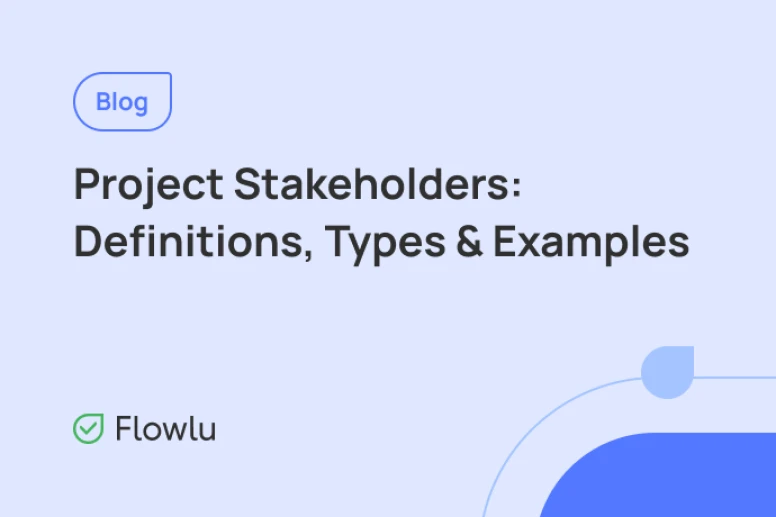What is a Project Stakeholder?
Stakeholder is your client, competitor, team, the whole company you work in, and even more. This article will help you to figure out the definition of project stakeholder, its types and roles. But all that matters is that we’ll help you to understand their needs and provide a positive effect.
Project Stakeholder: Definition
Simply put, stakeholders are people who are interested in your project. But they are not just people who want to have an output, because they will be influenced by your projects in different stages of its lifecycle. And the influence will define their opinion, which can be critical in the long term. Their decisions and input will affect your project as well. So one of the important things in project management is to make your stakeholders happy and provide them with only positive experiences.
During the process of project development, needs and expectations of stakeholders are different. Moreover, the influence of stakeholders can be changed from stage to stage of a project. But when you meet a clash of stakeholders’ interests, how can you manage this situation? How to control their opinion and keep it positive?
As a project manager, you have to clearly define their types, needs and roles to successfully manage them through the project.
Types of Stakeholders
As their opinion and influence can differ, there are three types of stakeholders. They vary on its role in a project.
Key Stakeholders
Key stakeholders are the most affected audience of your project. They might be investors or people who made some contributions during the planning process or are still helping with their ideas and assignments. In a nutshell, any stakeholder can be a key one. They can be a part of a focus group to rate your project, or maybe be experts in certain fields to positively review your product or service and bring a positive effect.
In most cases, key stakeholders are playing an active role in a project lifecycle. Stakeholders’ power lay in risks minimizing, resources provision, business development and smooth workflow. Each key stakeholder is a part of success, because they define the path of a project and provide you with a clear strategy.
Internal Stakeholders
As the name suggests, internal stakeholders are people who are directly involved in the project decision-making process. They mostly have not just a financial interest in your project, but also a personal one. They’re employees, investors, other departments of your company, board of directors, management team and many more.
Furthermore, even a customer can be an internal stakeholder. You might be wondering how, but it’s purely clear if you’re working on product or service development as a vendor. In that case, you have to rely not just on the opinion and decisions of your team, but also on clients’ ideas and point of views.
External Stakeholders
External stakeholders are not a part of the project team and don’t make any decisions, but they have a huge impact on the result from outside. For example, they can be governmental entities, customers and clients, distributors, competitors, communities, media, etc.
Roles of Stakeholders in Project Management
You can imagine as many roles of stakeholders as you can, because it depends on the project, company and industry you’re working in, but I’d like to mention some main roles that can affect any project. Here are a few examples of such roles:
- Managers.
- Team members.
- Board of directors.
- Executives.
- Investors.
- Sponsors.
- Vendors.
- Customers.
- Users.
- Suppliers.
This is not a complete list of stakeholders, but you might already be scared of such a large number of people whose opinion can affect your project in both positive and negative ways, right? You don’t need to worry, because you don’t have to satisfy all their needs in a whole, but a comprehensive strategy that will cover most essential needs is vital. To focus on a profitable audience and define a proper strategy, you have to identify your stakeholders and analyze them.
Roles are unique and have a separated spheres of influence. The list below will highlight some key importance of stakeholders:
- Defining the service. They are defining the services’ purpose and evaluating it.
- Supporting your project with ideas and updates. Mostly, internal stakeholders are always involved in the process of making key decisions and updates. But what if it works for external stakeholders too? Let your clients and users set something up and keep them regularly informed of updates.
- Monitoring the project. Each activity and operation can directly affect not just key stakeholders, but some of them are on the long distance as well. Rely on their opinion and develop your project to make it appropriate for the final user. While stakeholders are monitoring your service, you will be provided with the most up-to-dated information.
How to Identify and Analyze Stakeholders
Process of stakeholders’ identity and analysis is the basis of each project. Moreover, it’s one of the essential parts, because it is performing right after project charter and scope are established. Here are the essential steps of stakeholders’ analysis that will help you to build a strong stakeholders management strategy:
Step 1. Identify your stakeholders
To identify your stakeholders, you have to understand the main goal of the project and what needs it covers. Look through your project scope and charter. It will help you to define both internal and external stakeholders.
It’s important to note that not all stakeholders are involved in the interaction with your product or service from the beginning, some of them will come later. But it doesn’t mean that you don’t have to think about communication with such a cohort from the project’s start. Do the spadework first and your stakeholders will be happy later.
Step 2. Prioritize them
As it was mentioned before, there is such a type as a key stakeholder. One of the most important steps of your path as a project manager is to define your key stakeholders. Why do you need to focus on key stakeholders? This is because they are making key decisions and investments in your project, so focusing your resources on making them happy is a main priority. But it’s essential not just to influence them in the right way, but also to do that at the right time.
There is a simple, but effective way to prioritize stakeholders — a power/interest grid. Such an analysis consists of two simple questions, but once you answer them, you will define your key stakeholders to focus on them. Here are these questions:
- What influence do they have?
How important is their opinion? And how much influence do they have on other stakeholders, projects’ team and final result? As we’ve mentioned, influence can be both positive and negative, so it’s better to consider all risks.
- How does your project affect them?
Are they directly affected by your project or just slightly connected? Are they your competitors or a part of the team? Will your project results affect them in a financial way?
As their power and interest in your project grows, you have to maintain closer communication with them. If they’re key stakeholders with a huge influence, it’s essential to keep them satisfied, while just interest leads to providing them with more information (for example, on social media). Yet their interest and power is low, just keep monitoring them, because who knows, maybe they’ll become your key stakeholders later.
3. Keep closer connection with your stakeholders
Once you’ve found your stakeholders and prioritized them, you have to build a strong connection with them to understand their needs and expectations.
Speaking about key stakeholders, such an activity can involve personal meeting with investors or influencers. But what do you need to discuss? There are a few tips to help you to understand stakeholders’ expectations:
- Ask about what they truly expect from your project and about their experience.
- What project are they defining as a successful one?
- Define both positive and negative outcomes and how it will affect them.
It’s also crucial to prevent clashes of interests. Your key stakeholders might have different expectations and priorities. That’s why you have to perform not just a single face-to-face meeting, but maybe the whole board of stakeholders.
Analyze them with not only project expectations, but also with their cultural and even political specifics to prevent conflicts. You don’t need to indulge your stakeholders. Sometimes it’s important to lower their expectations. Keep them always involved and informed, even with internal updates of your team, because only this way will help you to build and manage a strong connection with stakeholders.
Summary
Stakeholders are highly affected by your project, but it works both ways, so you have to develop and maintain your project stakeholders’ communication strategy. It’s one of the key-tasks for each project manager, because projects can be affected positively and negatively. Fulfill their prospects but don’t forget about projects’ purpose. Managing stakeholders is about balance, so once you define and analyze them, it becomes an eternal rush to keep their needs covered.
A project stakeholder is a person or group interested in the project, influenced by its various stages, and whose decisions and input can significantly impact the project's outcome. Their satisfaction is crucial for the project's success.
The three main types of stakeholders are Key Stakeholders, who have a significant interest and influence over the project; Internal Stakeholders, who are directly involved in the decision-making process; and External Stakeholders, who influence the project from outside without direct decision-making power.
Identifying and analyzing stakeholders is crucial because it helps in understanding their needs, expectations, and influence levels. This information is essential for prioritizing stakeholder engagement and tailoring communication strategies to ensure the project aligns with their interests and maximizes positive outcomes.











